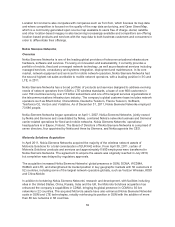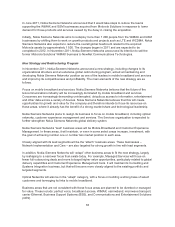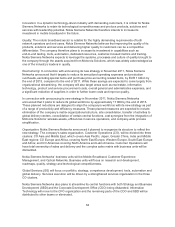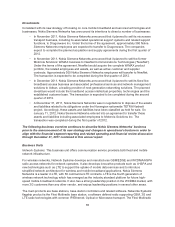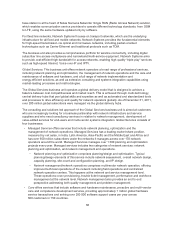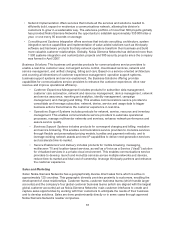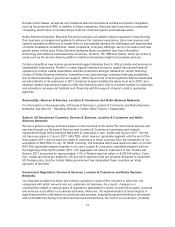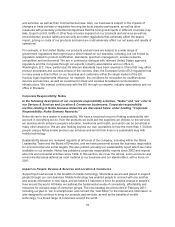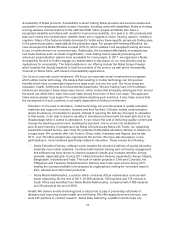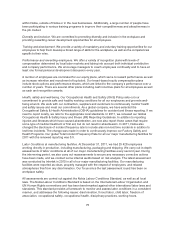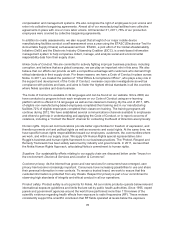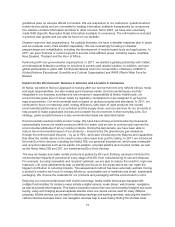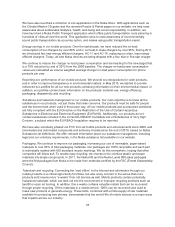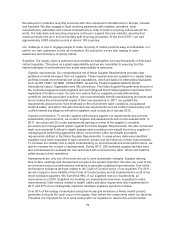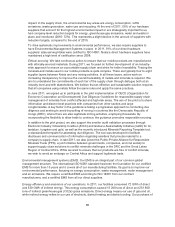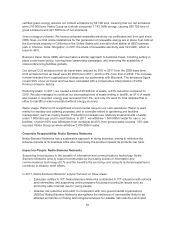Nokia 2011 Annual Report Download - page 73
Download and view the complete annual report
Please find page 73 of the 2011 Nokia annual report below. You can navigate through the pages in the report by either clicking on the pages listed below, or by using the keyword search tool below to find specific information within the annual report.Ericsson and Huawei, as well as non-traditional telecommunications entities and system integrators,
such as Accenture and IBM. In addition to these companies, there are also local service companies
competing, which have a narrower scope in terms of served regions and business areas.
Nokia Siemens Networks’ Business Solutions business unit assists network operators in transforming
their business, processes and systems to enhance the customer experience, drive new revenue and
improve operational efficiency to enable them to successfully address the challenges and opportunities
of mobile broadband, smartphones, tablet computers, multi-play offerings, service innovation and new
growth areas. In this area, Nokia Siemens Networks faces competition also from information
technology and software businesses like Accenture, Amdocs, HP, IBM and Oracle, which are active in
areas such as the service delivery platform market and business insight and analysis services.
Certain competitors may receive governmental support allowing them to offer products and services at
substantially lower prices. Further, in many regions restricted access to capital has caused network
operators to reduce capital expenditure and has produced a stronger demand for vendor financing.
Certain of Nokia Siemens Networks’ competitors may have stronger customer financing possibilities
due to internal policies or government support. While the amount of financing Nokia Siemens Networks
provided directly to its customers in 2011 remained at approximately the same level as in 2010, as a
strategic market requirement it plans to offer this financing option only to a limited number of customers
and primarily to arrange and facilitate such financing with the support of export credit or guarantee
agencies.
Seasonality—Devices & Services, Location & Commerce and Nokia Siemens Networks
For information on the seasonality of Devices & Services, Location & Commerce and Nokia Siemens
Networks, see Item 5A. “Operating Results—Certain Other Factors—Seasonality.”
Sales in US Sanctioned Countries: Devices & Services, Location & Commerce and Nokia
Siemens Networks
We are a global company and have sales in most countries of the world. We sold mobile devices and
services through our Devices & Services and Location & Commerce businesses and network
equipment through Nokia Siemens Networks to customers in Iran, Sudan and Syria in 2011. We did
not have any sales in Cuba in 2011. NAVTEQ, which was our reportable segment until the end of the
third quarter 2011, did not have any sales to customers in those countries from the completion of our
acquisition of NAVTEQ on July 10, 2008. Currently, the business which was reported under our former
NAVTEQ reportable segment resides in our new Location & Commerce reportable segment as from
the beginning of the fourth quarter 2011. Our aggregate net sales to customers in Iran, Sudan and
Syria in 2011 accounted for approximately 1.4% of Nokia’s total net sales, or EUR 545 million. Cuba,
Iran, Sudan and Syria are subject to US economic sanctions that are primarily designed to implement
US foreign policy, and the United States government has designated these countries as “state
sponsors of terrorism.”
Government Regulation: Devices & Services, Location & Commerce and Nokia Siemens
Networks
Our business is subject to direct and indirect regulation in each of the countries in which we, the
companies with which we work and our customers do business. As a result, changes in or
uncertainties related to various types of regulations applicable to current or new technologies, products
and services could affect our business adversely. Moreover, the implementation of technological or
legal requirements could impact our products and services, manufacturing and distribution processes,
and could affect the timing of product and services introductions, the cost of our production, products
71



